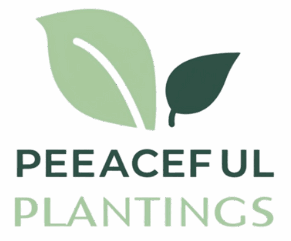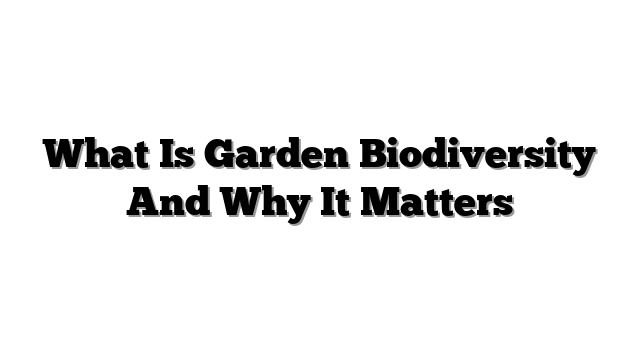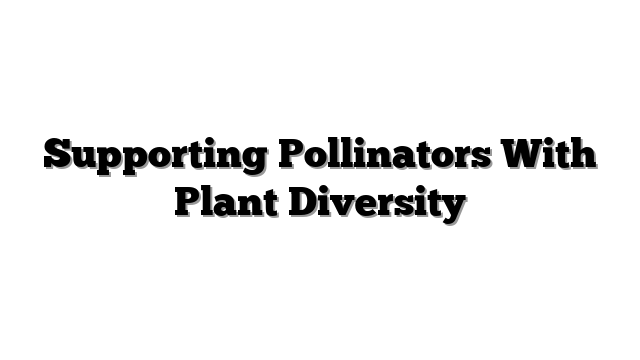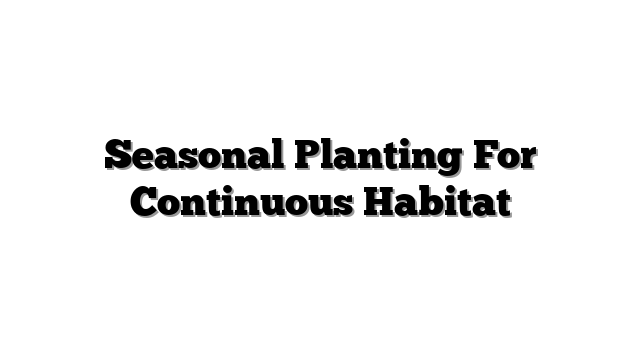What Is Garden Biodiversity And Why It Matters
Garden problems happen. Plants might look sad. Pests seem endless. Diseases spread fast. Maybe your garden feels stuck. It might need more life. The key is life itself.
Meet garden biodiversity. This means having many kinds of life. It includes plants. It includes bugs. It includes tiny things in the soil. Your garden space becomes a home. Many different living things share it.
We will explain garden biodiversity. We show why it helps your garden. It makes your garden strong. It makes it beautiful. We talk about 2025 gardening. You get simple steps. You learn how to add more life. This guide is for beginners too. It helps plant health.
This article covers many parts. We define biodiversity first. We look at its big benefits. Then we share ways to grow a diverse garden. We pick plants. We help wildlife. We care for soil. We think about garden layout.
Understanding garden biodiversity helps. It builds a better garden.
Understanding garden biodiversity is key. It means more than many flowers. It is about all life. Think of plants. Think of animals. Think of tiny things. They all live together.
Biodiversity means variety. It applies to a garden space. It is not just plant types. It includes insects. It includes birds. It includes worms. It includes tiny soil organisms. It is a community of life.
Variety exists on different levels. Genetic variety matters. This means different types of the same plant. One tomato kind differs from another. Species variety is important. Have many kinds of plants. Also have different bugs. Add different soil life. Ecosystem variety helps too. Your garden has different spots. Sunny spots differ from shady spots. Wet spots differ from dry spots. Each spot hosts different life.
Many things make up this life. Plant life is the start. Trees give shade. Shrubs offer shelter. Perennials return each year. Annuals bloom one season. Groundcovers protect soil. Edibles feed us. Native plants help local life.
Insect life is busy. Some bugs eat pests. They are beneficial insects. Some move pollen. These are pollinators. Bees are pollinators. Butterflies help too. Some insects break things down. They clean the garden.
Soil life works hard. Tiny microbes live there. Bacteria work. Fungi help plants. Worms dig tunnels. Nematodes live there too. They form a soil food web. This web feeds plants.
Other wildlife visits. Birds eat seeds. They eat insects. Frogs catch bugs. Lizards hide. Small mammals may visit. All these parts connect.
Different parts help each other. Plants feed insects. Insects pollinate plants. Some insects control pests. Soil life feeds the plants. This variety makes a garden strong. It creates a healthy place.
Now we know what it is. Let us see why it matters. It truly helps your garden. It brings big benefits.
A biodiverse garden helps itself. It controls pests naturally. Many insects live there. Some insects eat other bugs. These are predators. Ladybugs eat aphids. Some insects lay eggs on pests. These are parasitoids. They keep pest numbers low. You need fewer chemicals. Plants resist diseases better too. This is natural protection. We call this Integrated Pest Management. It uses nature’s helpers.
Soil health gets better. Many microbes live in rich soil. They break down dead leaves. They turn them into food. This feeds your plants. They cycle nutrients well. Soil structure improves. It holds water better. It gets air. You need less fertilizer. This builds a strong soil food web. Microorganisms are key workers. They keep soil alive. A study in 2023 showed this link clearly. Diverse soil microbes mean healthier plants.
Biodiversity attracts pollinators. Bees are needed. Butterflies are needed. Other insects help too. They move pollen between flowers. Many fruits and vegetables need this. Your garden provides food for them. It offers homes. It has flowers blooming all year. This keeps pollinators happy. Attracting wildlife helps everyone.
A diverse garden is tough. It handles hard times better. Hot weather happens. Dry spells occur. New pests might arrive. If one plant struggles, others do fine. The garden system stays stable. It is more resilient. This helps with climate change issues. Plants stay healthier.
Less maintenance is needed. A balanced garden works for you. It controls pests. It improves soil. It needs less watering sometimes. This saves you work. It supports sustainable gardening practices.
The garden looks lovely. Many different plants offer beauty. Colors change often. Textures vary. Life moves everywhere. It is educational too. You see nature working.
Biodiversity fits sustainable gardening. It works with nature. It builds a strong garden ecosystem.
How do you build this system? Start with picking plants. Your choices matter greatly.
Native plants are a top choice. They grew here naturally. Local insects need them. Local wildlife depends on them. They co-evolved together. Natives provide the best food. They offer the right shelter. Many gardeners choose natives in 2025. Find plants from your area. Local nurseries can help. Online resources list native species.
Mix up your plant types. Do not just plant flowers. Add trees for height. Use shrubs for structure. Plant perennials that return. Grow annuals for quick color. Include groundcovers. Plant vines. Add grasses. Grow food plants. This creates homes for more life.
Build layers in your garden. Think vertically. Tall trees form a top layer. Shrubs go below. Smaller plants fill in the middle. Groundcovers hug the soil. Vertical layers offer different habitats. Birds use branches. Bugs hide below leaves. This helps small gardens too. Use containers. Stack them up.
Have flowers bloom at different times. Spring blooms feed early bees. Summer flowers feed butterflies. Fall blooms help late pollinators. Keep food available all year. This supports pollinators constantly.
Try companion planting. Some plants help others. Marigolds may keep pests away. Beans add nitrogen to soil. Plant them near corn. Herbs attract helpful bugs. It uses natural pest control. Beneficial insects find food and shelter.
Look at plant details. Choose plants with different flowers. Some are flat for bees. Some are deep for hummingbirds. Vary colors. Vary leaf types. Add plants with berries. Add plants with seeds. This feeds many creatures.
Look at your garden now. What is missing? Plan new plantings. Add a native shrub. Plant a patch of wildflowers. Start small. You can find lists of plants. Pick ones good for your area.
It is not just about plants. Support the life around them. You cultivate wildlife. You care for soil life.
Create homes for animals. They need places to hide. Plant dense shrubs. Make a pile of logs. Leave some brush. Offer water. A bird bath is simple. A shallow dish helps insects. A small pond brings frogs.
Provide food for wildlife. Flowers offer nectar. Berries feed birds. Seeds feed birds too. Some plants are host plants. Caterpillars eat their leaves. Monarchs need milkweed. Do not clear everything. Leave leaf litter. Leave dead plant stems. Insects hide there in winter. This creates habitat. Attracting wildlife happens naturally. It brings pollinators and beneficial insects.
Care for your soil ecosystem. Healthy soil is the base. It holds all the life. It feeds your plants.
Add organic matter. Compost is great. Mulch beds with wood chips. This feeds soil microbes. It helps worms. Soil health improves greatly. Organic gardening feeds the soil.
Avoid chemicals. Pesticides kill pests. They also kill good bugs. They harm soil life. Fertilizers can hurt microbes. Choose organic practices. Use natural pest control methods. This keeps plants healthy. It protects the soil food web.
Do not dig soil too much. Tilling breaks up soil. It kills good organisms. It harms soil structure. Try not to disturb soil.
Simple steps help a lot. Put out a water dish. Start a small compost pile. Stop using bug sprays. Leave some leaves under bushes. You build a home for life.
How do you fit it all in? Design your garden well. Integrate these ideas into your layout.
Plan your biodiverse space. Look at your yard first. Where is sun? Where is shade? What is your soil like? What is already there?
Group plants together. Plants needing sun go together. Plants liking wet soil go together. Zone your garden.
Connect different areas. Make a path near the water source. Lead it to a hiding spot. Edges are important places. Where the lawn meets a garden bed. Where woods meet open space. Many different things live there.
Biodiversity works in any size garden. Small gardens help too. Urban spaces matter. Use vertical gardening. Grow plants up walls. Use containers. Maximize small areas. Container gardening brings life up close. Larger yards offer more room. Create meadows. Plant woodland edges. Make areas just for wildlife.
Use sustainable practices. Manage water wisely. Collect rain water. Use rain barrels. Build a rain garden. Pick plants that handle dry times. Drought-tolerant natives work well. Smart watering helps plants. It supports diverse plant needs.
Reduce your lawn area. Lawns have little life. Replace some lawn with plants. Add a flower bed. Plant a small grove of trees.
Draw a simple map of your yard. Where can you add a native plant? Where can you add water? Start small. Change one area first. Make it more biodiverse.
People ask questions. Here are some answers.
What is the easiest way to start? Plant a few native flowers. Add a bird bath. Use less bug spray. Leave some leaves in fall. These are simple steps for gardening for beginners. They help add native plants.
Does garden size matter? Any space helps. A balcony matters. Containers make a difference. A small patch of native flowers helps. Small gardens support life. Urban gardening counts. Container gardening adds variety.
Will more wildlife mean more pests? You see more bugs. You also get their eaters. Natural predators arrive. They eat the pests. The system balances itself. Pests cause fewer problems. This helps plant health.
How long does it take to see results? Some things happen fast. Pollinators visit quickly. Other things take time. Soil health improves slowly. A balanced pest system takes seasons. Plant health gets better over time.
What about invasive species? They are not good for biodiversity. They push out native plants. They harm the ecosystem. Choose native species. Manage invasive plants carefully.
We covered garden biodiversity. It means many kinds of life. It is essential for a healthy garden. It brings many benefits. It helps soil. It controls pests. It makes gardens resilient. It makes them beautiful.
You can add biodiversity. Choose native plants. Create homes for wildlife. Care for your soil. Plan your garden layout.
Understanding What Is Garden Biodiversity and Why It Matters is key. It builds a strong garden. It creates a sustainable space. It makes gardening enjoyable in 2025.
Start small. Watch your garden change. Enjoy creating a living space. Explore more about native plants for your area. Learn about composting. Find tips for plant health.




